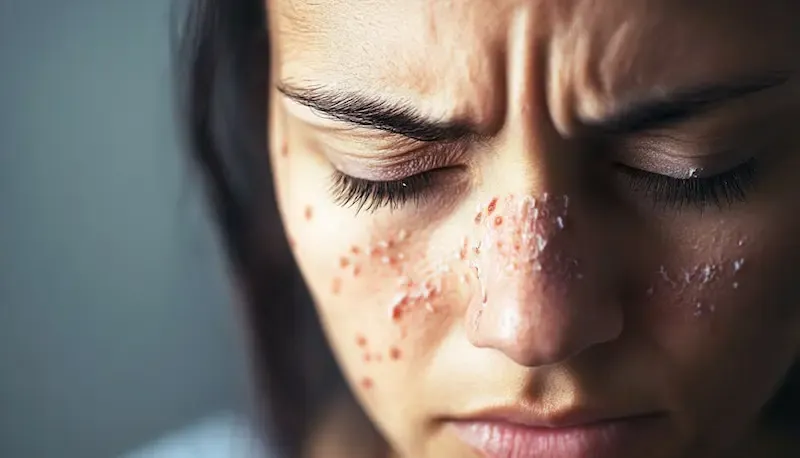Shingles is more than just a painful skin rash; it’s a significant public health concern that affects millions of adults each year. Caused by the reactivation of the varicella-zoster virus—the same virus responsible for chickenpox—shingles can lead to intense discomfort and long-lasting complications. Understanding this viral condition is crucial, especially as we age. With one out of three people in the United States likely to develop shingles at some point in their lives, being informed is our best defense.
Knowledge about the causes and management options available can empower you or someone you care for to navigate this challenging health issue effectively. From recognizing early symptoms to exploring treatment paths and preventive measures, every piece of information counts. As we delve deeper into shingles, you’ll discover practical strategies for relief and insights on how lifestyle changes can strengthen your immune system against future outbreaks. Let’s uncover the truths behind shingles together so you can take control of your health journey with confidence.
What is Shingles?
Shingles, medically known as herpes zoster, is a painful viral infection that arises from the reactivation of the varicella-zoster virus (VZV), which also causes chickenpox. After an individual recovers from chickenpox, typically during childhood, the virus lies dormant in the nerve tissues. Years later, this latent virus can reactivate due to various triggers including stress, a weakened immune system, or aging. This reactivation leads to shingles—a condition characterized primarily by a distinctive and often uncomfortable rash.
The symptoms of shingles often begin with a tingling or burning sensation in a localized area on one side of the body, followed by a painful rash that can develop into fluid-filled blisters. The rash usually appears within a few days of the initial discomfort. Other common symptoms may include fever, chills, headache, and fatigue. For instance, someone might start to notice significant pain radiating along their ribcage just before they see any visible signs; this kind of warning signal is crucial for early recognition and prompt treatment.
It’s important to note that shingles doesn’t discriminate based on age or health status but predominantly affects older adults or those with compromised immune systems. The rash itself typically follows the path of nerves affected by the dormant virus and generally resolves within two to four weeks; however, this can vary greatly among individuals. Beyond just being physically uncomfortable, the emotional impact of experiencing shingles—such as anxiety over potential postherpetic neuralgia (PHN)—can add another layer of complexity to its management.
Understanding what shingles entails is essential not only for those who have experienced it first-hand but also for caregivers and loved ones providing support. The connection between VZV and shingles highlights the importance of awareness regarding past chickenpox infections and ongoing health practices that may increase susceptibility to outbreaks in adulthood. Recognizing these aspects sets the stage for improving management strategies and enhancing supportive care for affected individuals.
Causes of Shingles

One of the primary factors that increase the risk of shingles is age. Adults over the age of 50 are significantly more likely to experience a shingles outbreak, largely due to a natural decline in immune function as we age. The immune system plays a crucial role in keeping dormant viruses at bay, and a weakened defense can allow the varicella-zoster virus, which remains inactive following a chickenpox infection, to reactivate and manifest as shingles. This increased susceptibility underscores the importance of health screenings and immunizations in older adults.
In addition to age, various conditions affecting one’s immune status could elevate the risk for shingles. Individuals with compromised immune systems—whether due to autoimmune disorders, cancer treatments like chemotherapy, or long-term use of immunosuppressive medications—may find themselves at greater risk for reactivation of this dormant virus. Stress is another contributor worth mentioning; chronic physical or emotional stress can impair immune response and potentially trigger an outbreak. This interplay between stress levels and immune health highlights how our lifestyle choices not only affect physical well-being but also influence our vulnerability to viral infections.
It’s critical to recognize that shingles is directly linked to a previous infection with chickenpox since both conditions arise from the same virus: varicella-zoster. After recovering from chickenpox, typically during childhood, some remnants of the virus remain inactive in nerve cells throughout our bodies. As life progresses, particularly when faced with various stressors or declining immunity, these virus particles may reactivate, resulting in painful rashes associated with shingles. Understanding this connection emphasizes that past experiences with chickenpox have long-reaching implications on our health later in life.
By addressing both intrinsic (like age) and extrinsic factors (such as stress management and overall immune health), it becomes possible not only to reduce individual risks but also foster more informed communities aware of shingles’ impact. With proactive measures such as vaccinations against varicella-zoster available for older adults—and education about recognizing symptoms—the landscape surrounding shingles can be managed more effectively.
Recognizing Symptoms Early
Identifying the early signs of shingles is crucial for effective treatment and management. Before the characteristic rash emerges, individuals may experience a range of warning symptoms that can be easy to overlook. These include localized pain, tingling, or burning sensations along a specific area of the body. For example, someone might initially notice a peculiar sting on their side or back that they brush off as mere muscle strain. Additionally, other general symptoms such as fatigue, headache, fever, and sensitivity to light can also accompany this initial phase. Understanding these subtle cues is key to catching shingles early.
Prompt diagnosis plays an essential role in mitigating the severity of shingles and possibly preventing complications such as postherpetic neuralgia (PHN), which can cause long-lasting pain even after the rash heals. If you or someone you know experiences unexplained pain in addition to any aforementioned symptoms, it’s prudent to consult a healthcare provider without delay. Early intervention with antiviral medications not only helps reduce the duration of the illness but can also lessen the intensity of associated pain.
Moreover, awareness of these preliminary symptoms empowers individuals to take action timely rather than waiting for more severe manifestations like blisters or rashes. Shingles tends to present itself in phases; recognizing when something feels amiss could mean the difference between experiencing mild discomfort versus extensive recovery periods. As soon as one suspects they might have shingles based on these early indicators, seeking medical attention can lay down a path toward a more manageable recovery period filled quality resources and support options.
Being vigilant about bodily changes and acknowledging them as potential signs of shingles opens avenues for faster treatment and relief. Developing an awareness not only aids your health but fosters better communication with healthcare providers about emerging concerns – leading to better outcomes overall.
Available Treatment Options

When it comes to managing shingles, early intervention is crucial for alleviating symptoms and reducing the potential for long-term complications. Antiviral medications such as acyclovir, valacyclovir, and famciclovir play a pivotal role in treating shingles. These medications can help speed up recovery by shortening the duration of the outbreak and minimizing the severity of symptoms. For instance, starting treatment within the first 72 hours of rash onset can significantly reduce pain and prevent further complications like postherpetic neuralgia (PHN), which can lead to lingering discomfort for months or even years after the rash resolves.
In addition to antiviral therapies, effective pain management strategies are essential in improving quality of life during a shingles outbreak. Patients often experience intense burning or throbbing pain that can be debilitating. Over-the-counter pain relievers such as acetaminophen or ibuprofen may provide some relief. However, healthcare professionals may also prescribe stronger pain medications, including opioids or topical analgesics like lidocaine patches, for those with severe discomfort. Complementary therapies such as acupuncture and transcutaneous electrical nerve stimulation (TENS) units have shown promise in providing additional relief from nerve-related pain.
It’s also worth exploring various home remedies that individuals may find helpful alongside conventional treatments. A cool compress applied to the affected area can soothe inflamed skin and reduce itching. Herbal teas like chamomile or lemon balm may offer calming effects to combat anxiety related to outbreaks. Previously mentioned lifestyle adjustments—such as maintaining a balanced diet rich in antioxidants—can support overall immunity, aiding both recovery from shingles and potentially preventing future occurrences.
It’s imperative for those experiencing symptoms of shingles to consult their healthcare provider promptly about treatment options tailored to their specific needs. With timely medical intervention and appropriate management strategies, most individuals find considerable relief from both the physical and emotional challenges that this viral infection presents. Understanding these available treatment options empowers patients not just to cope but to reclaim their well-being during challenging episodes of illness.
Home Remedies and Lifestyle Adjustments
When dealing with shingles, many individuals seek ways to manage their symptoms at home alongside conventional treatments. Natural remedies can provide additional comfort and may help reduce the discomfort associated with shingles. One effective option is applying cool compresses to the affected areas, which can alleviate itching and inflammation. Consider using a clean towel soaked in cold water or even adding a few drops of essential oils like lavender for added relaxation benefits. Another useful home remedy is oatmeal baths; colloidal oatmeal is known for its soothing properties and can help calm irritated skin while providing hydration.

In addition to topical treatments, certain dietary adjustments may also have a positive impact on your immune health, potentially reducing the risk of future outbreaks. Incorporating foods rich in antioxidants—such as berries, nuts, and leafy greens—can help combat oxidative stress in the body, fostering a stronger immune response. Vitamin C-rich foods like oranges and bell peppers are especially crucial as they contribute significantly to immune function. Staying well-hydrated by drinking plenty of water is equally important; it supports overall health and helps maintain optimal skin condition.
Furthermore, lifestyle changes play a vital role in enhancing immune resilience against infections such as shingles. Regular physical activity not only boosts immunity but also reduces stress levels—a significant trigger for shingles recurrences. Engaging in moderate exercise like walking or yoga can improve your overall mental well-being while keeping your body fit to fight infections effectively. Additionally, prioritizing sufficient sleep enhances the body’s natural defense mechanisms; aim for 7-9 hours each night to allow your system to repair itself efficiently.
Finally, mindfulness practices like meditation or deep-breathing exercises can further bolster emotional resilience during times of discomfort. Stress management techniques are key since heightened stress levels may lead to flare-ups of shingles due to their impact on the immune system. By combining these natural remedies with lifestyle adjustments aimed at strengthening overall health, individuals affected by shingles can empower themselves toward recovery while minimizing future risks.
Prevention Strategies
Preventing shingles, while it may not be entirely foolproof, is certainly a feasible goal with several actionable strategies. One of the most effective measures is vaccination. The Centers for Disease Control and Prevention (CDC) recommends the Shingrix vaccine for adults aged 50 and over, which has shown to be more than 90% effective in preventing shingles and its associated pain. This two-dose vaccine regimen not only decreases the risk of developing shingles but also substantially lessens the likelihood of postherpetic neuralgia (PHN), a common complication that can cause long-lasting nerve pain after the rash has healed.
In addition to vaccinations, there are practical lifestyle changes that can bolster your immune system and reduce the risk of viral infections, including shingles. Regular physical activity serves as one significant component; engaging in moderate exercise a few times a week enhances circulation and supports overall health. A well-balanced diet rich in vitamins C and E, zinc, and beta-carotene can also help fortify the immune response. Incorporate foods like citrus fruits, nuts, leafy greens, and colorful vegetables into your meals to ensure you’re providing your body with essential nutrients.
Moreover, managing stress plays an undeniable role in maintaining a healthy immune system. Chronic stress can impair your body’s ability to combat infections effectively. Practicing mindfulness techniques such as yoga or meditation can promote relaxation and enhance emotional well-being. Quality sleep is another vital factor—aiming for seven to eight hours each night gives your body time to recover and regenerate cells important for fighting off infections. Cutting back on alcohol consumption and quitting smoking will further strengthen your bodily defenses against diseases like shingles.
In conclusion, taking proactive steps toward prevention through vaccination combined with healthy lifestyle habits is pivotal in combating shingles risks. By investing time in these preventive strategies today, you empower yourself with greater control over your health tomorrow—contributing not just to personal well-being but enhancing community resilience against this frequently misunderstood condition.
Caregiver Support and Resources
Caring for someone with shingles can be both a rewarding and challenging experience. As a caregiver, your primary focus will likely be on alleviating discomfort and providing emotional support to the individual affected. One of the most essential roles you can fulfill is helping manage symptoms. This includes encouraging rest, ensuring they stay hydrated, and offering soothing treatments like cool compresses for skin irritation. It’s also crucial to assist in medication management by keeping track of prescribed antiviral drugs and any pain relief options, which can significantly help reduce their suffering.
Effective communication is another key aspect of supporting someone with shingles. Encourage your loved one to express how they are feeling physically and emotionally so that you can better cater to their needs. It’s important to create an environment where they feel comfortable discussing their symptoms or any unexpected side effects from medications. Additionally, stay informed about shingles through reliable resources such as healthcare websites or local health departments to gain insights into managing the condition more effectively.
There are many communities and online forums dedicated specifically to people experiencing shingles or caregivers who support them. These platforms offer valuable advice, share personal experiences, and foster connections that can alleviate feelings of isolation. Consider seeking out local support groups which might host meetings or have resources regarding coping strategies that have worked for others facing similar challenges. Organizations like the National Shingles Foundation also provide educational materials designed to empower both patients and caregivers on how to navigate through this discomforting illness.
In summary, being an effective caregiver involves not just practical assistance but emotional understanding as well. By engaging in open dialogue with those affected by shingles while utilizing available community resources, you’ll cultivate a supportive atmosphere conducive for healing. Remember that self-care is equally important; taking care of your own physical and mental well-being ensures that you remain strong in your caregiving role.
Long-term Effects of Shingles
The aftermath of a shingles outbreak can linger far beyond the initial rash and discomfort. One of the most significant long-term effects is postherpetic neuralgia (PHN), a condition characterized by persistent nerve pain that occurs after the shingles rash has healed. This pain can be severe, often described as burning or stabbing, and may last for months or even years. The risk of developing PHN increases with age, affecting nearly 50% of those who have experienced shingles at some point in their lives if they are over 60 years old. For individuals, especially older adults, this kind of chronic pain can severely impact quality of life, making ordinary activities feel daunting.
In addition to PHN, there may be other complications stemming from shingles. In rare instances, the virus can lead to vision problems if it affects the eye—potentially causing scarring or infections that could result in permanent impairment. Additionally, shingles during pregnancy can pose risks to both mother and baby if not managed properly. Therefore, understanding these potential consequences emphasizes the importance of professional medical follow-up after recovering from an outbreak.
Follow-up care serves multiple purposes: monitoring for any signs of long-lasting side effects like PHN or additional complications and reassessing overall health outcomes. Patients are encouraged to maintain regular check-ups with their healthcare providers to manage symptoms effectively and explore treatment options that could alleviate lingering pain or discomfort. Moreover, open communication with healthcare professionals allows individuals to discuss any changes in their condition promptly and adjust management strategies as needed.
Engaging in discussions about experiences with shingles—whether through support groups or online forums—can also provide invaluable insights into coping mechanisms while fostering community support among those affected by similar challenges. Remembering that recovery doesn’t end once the rash resolves is crucial; taking proactive steps towards ongoing health maintenance will aid both physical well-being and mental comfort moving forward.
Wrapping Up: Taking Control of Shingles
In conclusion, understanding shingles is crucial for managing its impact on your health. We’ve explored the causes, recognized symptoms early, and delved into treatment options available to alleviate discomfort. Awareness of prevention strategies, including vaccination and lifestyle changes, can significantly reduce your risk of developing this viral infection.
If you or a loved one are experiencing symptoms of shingles, don’t hesitate to seek medical advice. Early intervention is key to effective management and recovery. Remember, knowledge is empowering—arm yourself with information and take charge of your health journey!





